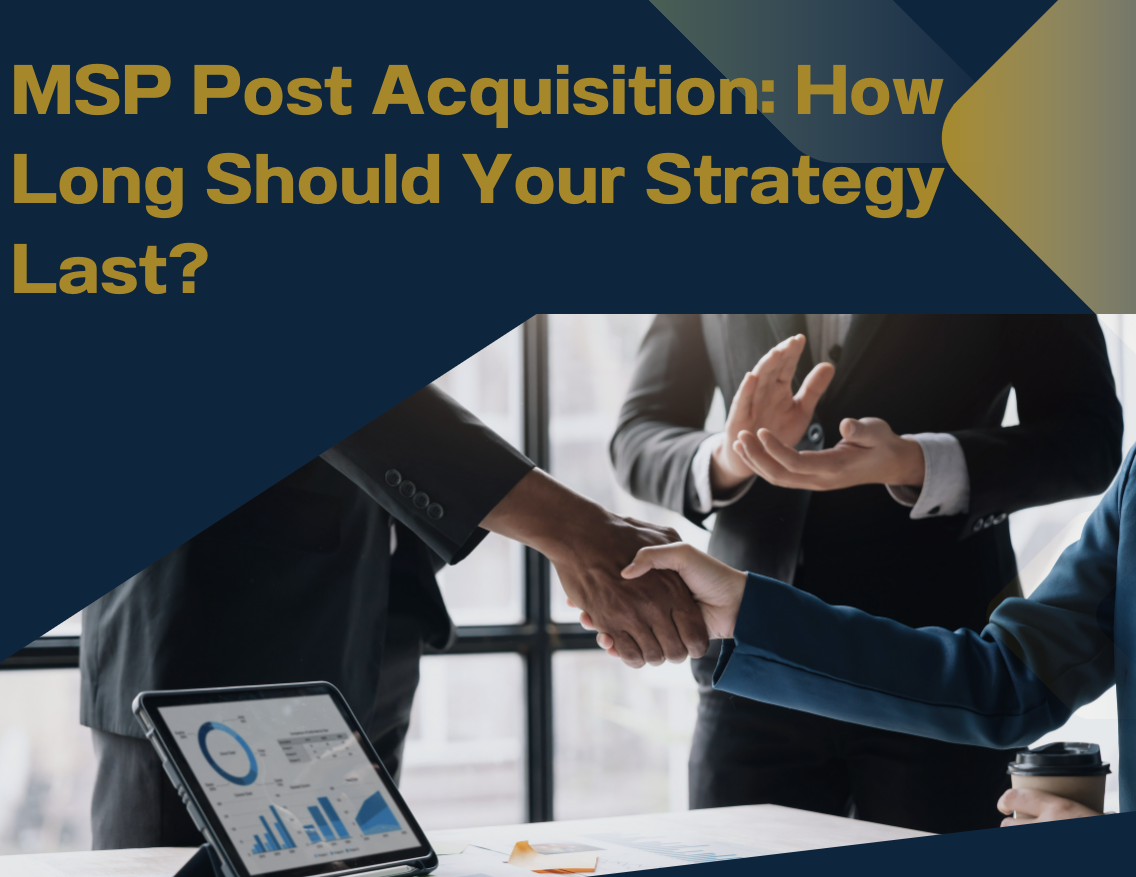The MSP acquisition process brings both exciting opportunities and significant challenges when blending companies, people, processes, and customers. A well-planned integration strategy and onboarding process is critical for maximizing the ROI of the acquisition and retaining top talent and valued clients. But how long should this process last to be effective? This article provides insights into how you can structure your post-acquisition strategy for the best results.
The Importance of a Comprehensive Integration Strategy
Going Beyond the Initial Welcome
For the acquiring company, assembling a dedicated integration team and extending a warm welcome to the new staff is an excellent way to start. However, this alone is not enough to ensure a smooth transition and protect the investment. The integration strategy must go beyond the initial welcome and address common challenges that arise post-acquisition:
- Adoption of new go-to-market strategies: This may include talking about the new focus or direction the company should take, such as the service focus, vendors and partnerships focus, and sales strategies. The existing team will have been well indoctrinated on the various strategies of their company; therefore, changing the approach will take time and continued effort for the team to adopt.
- Creating rapport between new and existing teams: This may even be the first time that the team hasn’t been able to walk down the hall to talk face-to-face with the CEO or ping them directly on chat. Given that a large part of the ROI of the acquisition will be dependent on retaining top talent, it is extremely important to have processes that will give confidence to both teams and enable them to reorient themselves to any new culture.
Adapting to Change Takes Time
For a well-run MSP that is acquired, the original staff is usually accustomed to the company’s established strategies, goals, processes, and partnerships. Changing this approach will require time and consistent effort for the team to adapt and adopt the changes. A comprehensive integration strategy should account for this adjustment period.
Key Elements of an Effective Integration Strategy
Ongoing Education and Communication
While an initial integration team can kick things off, there must be a process for continued communication, education, and coaching around the changes even after that team has moved on. This is vital for getting all teams rowing in the same direction and presenting a united front to clients. Some tips:
- Provide clarity internally on who the go-to experts and resources are for new services, processes and tools. Have ongoing sessions to familiarize teams and build confidence.
- Establish a cadence of team-building meetings and activities to build rapport over time. Make this a priority even amidst competing demands for time and attention.
Facilitating Trust Between Blended Teams
Blending teams is like blending families – it changes dynamics and can create uncertainty about roles, relationships, and values. To build trust among your workforce:
- Ensure managers and team leads are dedicating consistent one-on-one time to build rapport. Have them collaborate on crafting a joint agenda covering key goals while allowing time to build the relationship.
- Team up people with similar roles and skills to jointly participate in client meetings and projects. Facilitate creative interactions to build relationships one at a time.
- Spotlight team members in internal communications using both personal insights and professional experience to help people become familiar faster.
Transferring Trust to Clients
Long-term team members take pride in the trusted client relationships they’ve built. Newly introduced colleagues need to earn that same trust over time. Some ideas:
- Have existing and new team members jointly engage with clients so trust can be transferred through exposure and interaction.
- Provide clients with background on the skills and experience of new team members to build credibility and confidence.
Read Also: Solving MSP Client Retention Challenges After Merger and Acquisition
Determining the Timeline for Integration and Onboarding
It’s a Marathon, Not a Sprint
Effectively blending teams, adopting new strategies, building trust, and retaining clients post-acquisition is a marathon, not a sprint. Expecting it to happen immediately can create stress and lead to churn. Instead, the integration strategy and onboarding process should be designed with a longer-term view.
Planning for 12-24 Months
While every MSP acquisition is unique, a general guideline is to plan the integration and onboarding process to last 12-24 months:
- The first 3-6 months should focus on initial welcomes, education on new strategies and processes, and facilitating interactions between blended teams and with clients.
- The next 6-12 months reinforce the education, maintain the cadence of team building and one-on-ones, and continue to build trust through shared client engagements.
- The final 6-12 months will focus on fine-tuning the blended organization and measuring progress against goals for staff and client retention and the adoption of new strategies.
Regularly Assessing and Adjusting
Throughout the 12-24 month process, regularly assess what is working well and where challenges still exist. Solicit candid feedback from team members and clients. Adjust the integration strategy as needed based on these real-world inputs.
Maximizing ROI Through a Thoughtful Approach
MSP acquisitions provide exciting growth opportunities when the integration strategy incorporates longer-term processes to unite the organization. The ROI depends on retaining top talent who can carry forward trusted client relationships. By planning for an integration and onboarding process that lasts 12-24 months, acquirers can set themselves up for success in capturing the full value of their investment while minimizing churn. Building a cohesive, high-performing organization over time requires consistent effort applied with patience and determination.
How Call To Action Can Help?
Protecting valuable clients and employees from the pain of change will be one of the most important steps after any MSP acquisition process. As an experienced MSP advisor, I have been involved in a number of acquisitions, and I help companies ensure their acquisition due diligence process and post-acquisition expectations are met. Book a quick call with me today to learn more.



